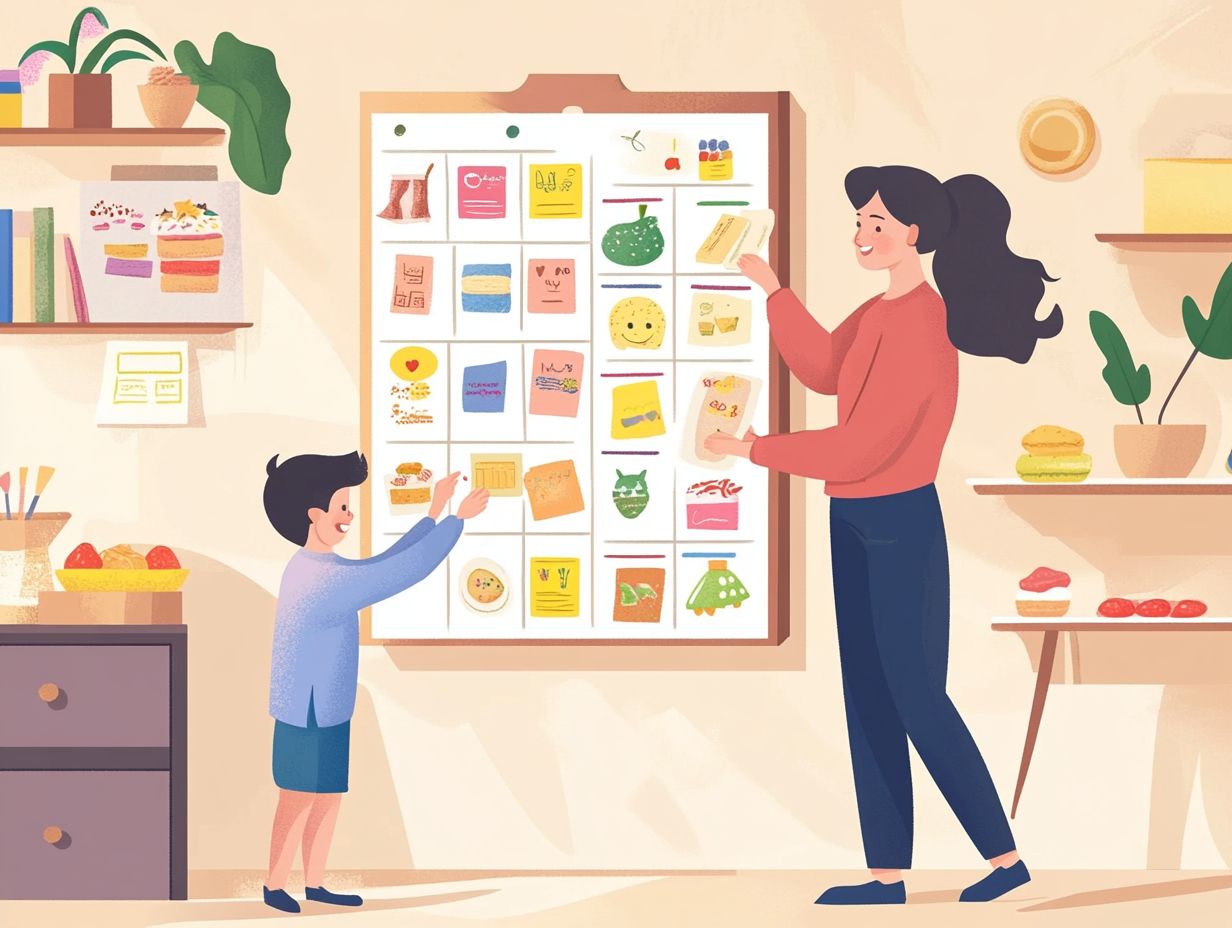How to Set Up a Reward System?
In today s competitive landscape, implementing a well-structured reward system can significantly boost your motivation and productivity, whether within your workplace or among your teams.
It s essential for you to grasp the differences between individual and group rewards, as well as the nuances of internal and external rewards, to craft an effective approach.
This article will guide you in setting clear goals, ensuring transparent communication, and maintaining consistency throughout the process.
You ll also discover how to track progress and make necessary adjustments, ensuring your reward system continues to thrive.
Let s dive in and unlock the secrets to boosting motivation now!
Contents
- Key Takeaways:
- The Importance of Reward Systems
- Types of Reward Systems
- Setting Goals for Your Reward System
- Implementing the Reward System
- Consistency and Fairness
- Maintaining and Adjusting the Reward System
- Tracking Progress and Making Changes
- Frequently Asked Questions
- What is a reward system and why is it important to set one up?
- How do I determine what type of rewards to include in my system?
- What are some best practices for setting up an effective reward system?
- Can a reward system also be used for non-work related activities?
- How can I ensure that my reward system is inclusive and fair for all individuals?
- What steps should I take to implement a new reward system?
Key Takeaways:

- Reward systems are crucial for motivating employees and promoting desired behaviors in the workplace.
- When setting up a reward system, consider individual vs. group rewards and internal vs. external rewards.
- Clearly define desired behaviors and establish measurable goals to effectively implement a reward system.
The Importance of Reward Systems
The significance of reward systems in child development is truly paramount. They provide a foundational framework for fostering positive behavior, utilizing techniques such as positive reinforcement and visual representation.
When you implement a well-structured reward system, you can effectively inspire school-aged children to achieve their behavior goals, enhancing not only their self-esteem but also their overall learning experience.
This systematic approach is easily customizable to meet individual needs, making it particularly effective in diverse learning environments.
Why Implement a Reward System?
Implementing a reward system is essential for cultivating motivational techniques that nurture both short-term and long-term goals in children, especially within a structured learning environment.
By integrating praise and rewards into this framework, you can effectively encourage positive behavior. These systems aid in behavioral modification.
They significantly enhance self-esteem among school-aged children. When they receive recognition for their accomplishments no matter how small it fosters a sense of achievement that inspires them to reach for even greater heights.
A well-structured reward system creates a positive learning atmosphere where children feel valued and supported. This ultimately leads to improved academic performance and personal growth.
Types of Reward Systems
Grasping the nuances of various reward systems, like the point reward system and the sticker reward chart, is essential for effectively modifying behavior in children. This knowledge gives caregivers and educators the power to select the most suitable approach tailored to each child’s unique needs.
Individual vs. Group Rewards
When you consider motivation techniques, understanding the difference between individual and group rewards can profoundly influence a child’s motivation and engagement levels.
Recognizing the intricacies of these reward systems is crucial for both educators and parents, as each method carries its own advantages and disadvantages. Individual rewards are great for promoting personal accountability.
They can also enhance self-esteem by acknowledging a child’s unique efforts. However, they might unintentionally create a competitive atmosphere among peers, potentially leading to feelings of isolation for those who find themselves struggling.
Conversely, group rewards emphasize teamwork and collaboration, fostering a sense of community. Yet, there’s a risk that individual contributions may become obscured.
This can diminish motivation if a child feels eclipsed by the achievements of others. By looking into these dynamics in various educational and home environments, you can develop more tailored approaches that truly enhance effectiveness.
Intrinsic vs. Extrinsic Rewards

Intrinsic rewards stem from internal satisfaction. In contrast, extrinsic rewards involve external recognition and tangible benefits. Both types are essential in Child Psychiatry and motivation.
Research shows that intrinsic rewards lead to deeper engagement with tasks. This boosts a child’s belief in their own abilities and creativity. Children driven by personal interests, rather than external incentives, tend to show greater persistence and skill development.
However, relying heavily on extrinsic rewards can result in a more superficial engagement. Children may complete tasks only for the rewards, undermining their intrinsic motivation. Finding the right balance is crucial for influencing therapeutic outcomes, allowing practitioners to customize strategies to meet each child’s unique needs.
Setting Goals for Your Reward System
Set clear goals for your reward system to inspire the behaviors you want to see. This guidance helps children achieve behavioral milestones in academic and social settings.
Identifying Desired Behaviors
Identifying desired behaviors is the first step in crafting an effective reward system that aligns with child development.
Recognize the specific actions you want to encourage. This could include sharing, following instructions, or showing empathy towards peers. Once you categorize these behaviors, you can reinforce them through positive feedback or appropriate rewards.
Effective strategies include:
- Observing interactions across various settings,
- Discussing expectations with caregivers, and
- Employing developmental checklists to ensure the identified behaviors match age-appropriate milestones.
This tailored approach fosters a deeper understanding of behavioral nuances. It also helps children learn to value positive actions as they grow.
Establishing Measurable Goals
Establishing measurable goals is essential in reward systems. It allows you to define and track short-term and long-term objectives.
This method enables you to visualize your progress clearly. Each milestone contributes to your overarching aim. Breaking complex aspirations into smaller, actionable tasks enhances clarity and cultivates a rewarding sense of achievement.
Regularly evaluate these objectives for insights into which strategies are effective. This iterative process maintains motivation and engagement, helping you stay focused and adapt to challenges.
Implementing the Reward System
Implementing a reward system requires prioritizing communication, consistency, and fairness. This ensures children understand the expectations and appreciate the benefits of their actions.
Communication and Transparency

Effective communication and transparency are crucial for implementing a reward system. They significantly impact children s motivation.
To create a supportive environment, clearly define the criteria for rewards. This helps children understand what is expected of them. Regular feedback reinforces positive behaviors and guides children in recognizing areas for improvement.
Engaging in open discussions about rewards fosters a shared understanding and excitement. This approach enhances motivation and encourages consistent effort from children.
Consistency and Fairness
Consistency and fairness in applying rewards are vital for effectively modifying behavior and maintaining trust in the reward system.
A stable environment with uniform rules makes children feel secure. Inconsistencies can create confusion and frustration.
A fair approach instills a sense of justice, encouraging children to develop a healthy understanding of expectations and consequences. This fosters their social skills and emotional resilience, setting the stage for their growth and development.
Maintaining and Adjusting the Reward System
To ensure long-term success, regularly fine-tune your reward system. This keeps it fresh and effective for everyone!
Regularly track progress and adapt the system based on the evolving needs of the children. This proactive approach ensures that the rewards remain relevant and effective, fostering motivation and engagement over time.
Tracking Progress and Making Changes
Tracking your progress and refining the reward system is crucial for ensuring ongoing support and guiding children to achieve their goals.
Utilizing tools like charts, journals, or apps provides a visual representation of achievements. Regular assessments be it monthly or weekly help you quickly spot what needs adjustment.
Engaging with the children during this process is vital; their insights can illuminate their motivations and any obstacles they face.
Ultimately, ongoing support elevates their morale and solidifies their progress, keeping them focused on their goals as they navigate challenges.
Frequently Asked Questions
What is a reward system and why is it important to set one up?

A reward system is a structured approach to recognizing and reinforcing positive behaviors or achievements in individuals or groups. It increases motivation, boosts performance, and improves overall satisfaction in various environments.
How do I determine what type of rewards to include in my system?
The type of rewards will depend on the specific goals and objectives. Some common types include monetary incentives, tangible gifts, recognition, time off, or opportunities for growth.
What are some best practices for setting up an effective reward system?
Best practices include aligning the system with organizational goals, being consistent and fair, regularly communicating and reinforcing the system, and reviewing it to ensure relevance and effectiveness.
Yes, a reward system can be used for any activity or behavior you wish to recognize and reinforce. This includes personal goals, family activities, or hobbies and interests.
How can I ensure that my reward system is inclusive and fair for all individuals?
To ensure inclusivity and fairness, involve all individuals in its development. Consider their diverse needs and preferences, regularly gather feedback, and communicate the criteria and process for earning rewards clearly.
What steps should I take to implement a new reward system?
The steps include identifying specific goals and objectives, determining the type of rewards to include, communicating the system to all individuals, tracking its effectiveness, and making necessary adjustments.






